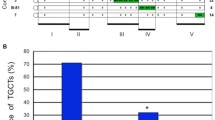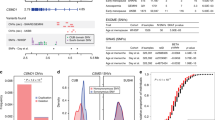Abstract
Chromosome substitution strains (CSS or consomic strains) are useful for mapping phenotypes to chromosomes. However, huge efforts are needed to identify the gene(s) responsible for the phenotype in the complex context of the chromosome. Here we report the identification of candidate disease genes from a CSS by using a combination of genetic and genomic approaches and by using knowledge about the germ cell tumor disease etiology. We used the CSS 129.MOLF-Chr19 chromosome substitution strain, in which males develop germ cell tumors of the testes at an extremely high rate. We were able to identify three protein-coding genes and one microRNA on chromosome 19 that have previously not been implicated to be testicular tumor susceptibility genes. Our findings suggest that changes in gene expression levels in the gonadal tissues of multiple genes from Chr 19 likely contribute to the high testicular germ cell tumor (TGCT) incidence of the 129.MOLF-Chr19 strain. Our data advance the use of CSS to identify disease susceptibility genes and demonstrate that the 129.MOLF-Chr19 strain serves as a useful model to elucidate the genetics and biology of germ cell transformation and tumor development.




Similar content being viewed by others
Abbreviations
- SNP:
-
single nucleotide polymorphism
- nt:
-
nucleotide
- qRT-PCR:
-
quantitative real-time polymerase chain reaction
- Chr:
-
chromosome
- TGCT:
-
testicular germ cell tumor
- PN1:
-
postnatal day 1
- E:
-
embryonic day
References
Anderson R, Copeland TK, Scholer H, Heasman J, Wylie C (2000) The onset of germ cell migration in the mouse embryo. Mech Dev 91:61–68
Antonicka H, Mattman A, Carlson CG, Glerum DM, Hoffbuhr KC, et al. (2003) Mutations in COX15 produce a defect in the mitochondrial heme biosynthetic pathway, causing early-onset fatal hypertrophic cardiomyopathy. Am J Hum Genet 72:101–114
Burtis KC, Baker BS (1989) Drosophila doublesex gene controls somatic sexual differentiation by producing alternatively spliced mRNAs encoding related sex-specific polypeptides. Cell 56:997–1010
Collin GB, Asada Y, Varnum DS, Nadeau JH (1996) DNA pooling as a quick method for finding candidate linkages in multigenic trait analysis: an example involving susceptibility to germ cell tumors. Mamm Genome 7:68–70
Crockford GP, Linger R, Hockley S, Dudakia D, Johnson L, et al. (2006) Genome-wide linkage screen for testicular germ cell tumour susceptibility loci. Hum Mol Genet 15:443–451
Dieckmann K-P, Skakkebaek NE (1999) Carcinoma in situ of the testis: review of biological and clinical features. Int J Cancer 83:815–822
Forman D, Oliver RT, Brett AR, Marsh SG, Moses JH, et al. (1992) Familial testicular cancer: a report of the UK family register, estimation of risk and an HLA class 1 sib-pair analysis. Br J Cancer 65:255–262
Glerum DM, Muroff I, Jin C, Tzagoloff A (1997) COX15 codes for a mitochondrial protein essential for the assembly of yeast cytochrome oxidase. J Biol Chem 272:19088–19094
Harland SJ, Cook PA, Fossa SD, Horwich A, Mead GM, et al. (1998) Intratubular germ cell neoplasia of the contralateral testis in testicular cancer: defining a high risk group. J Urol 160:1353–1357
Heimdal K, Olsson H, Tretli S, Flodgren P, Borresen AL, et al. (1996) Familial testicular cancer in Norway and southern Sweden. Br J Cancer 73:964–969
Hemminki K, Li X (2004) Familial risk in testicular cancer as a clue to a heritable and environmental aetiology. Br J Cancer 90:1765–1770
Horwich A, Shipley J, Huddart R (2006) Testicular germ-cell cancer. Lancet 367:754–765
Ilson DH, Bosl GJ, Motzer R, Dmitrovsky E, Chaganti RSK (1991) Genetic analysis of germ cell tumors: current progress and future prospects. Hematol Oncol Clin North Am 5:1271–1283
Jacobsen R, Bostofte E, Engholm G, Hansen J, Olsen JH, et al. (2000) Risk of testicular cancer in men with abnormal semen characteristics: cohort study. BMJ 321:789–792
Ju Z, Kapoor M, Newton K, Cheon K, Ramaswamy A, et al. (2005) Global detection of molecular changes reveals concurrent alteration of several biological pathways in nonsmall cell lung cancer cells. Mol Genet Genomics 274:141–154
Kawakami T, Zhang C, Okada Y, Okamoto K (2006) Erasure of methylation imprint at the promoter and CTCF-binding site upstream of H19 in human testicular germ cell tumors of adolescents indicate their fetal germ cell origin. Oncogene 25:3225–3236
Kehler J, Tolkunova E, Koschorz B, Pesce M, Gentile L, et al. (2004) Oct4 is required for primordial germ cell survival. EMBO J 5:1078–1083
Li C, Wong W-H (2001) Model-based analysis of oligonucleotide arrays: expression index computation and outlier detection. Proc Natl Acad Sci U S A 98:31–36
Looijenga LHJ, Stoop H, de Leeuw HP, de Gouveia Brazao CA, Gillis AJ, et al. (2003) POU5F1 (OCT3/4) identifies cells with pluripotent potential in human germ cell tumors. Cancer Res 63:2244–2250
Matin A, Collin GB, Asada Y, Varnum D, Nadeau JH (1999) Susceptibility to testicular germ-cell tumours in a 129.MOLF-Chr 19 chromosome substitution strain. Nat Genet 23:237–240
McDonald MT, Flejter W, Sheldon S, Putzi MJ, Gorski JL (1997) XY sex reversal and gonadal dysgenesis due to 9p24 monosomy. Am J Med Genet 73:321–326
Molyneaux KA, Wang YC, Schaible K, Wylie C (2004) Transcriptional profiling identifies genes differentially expressed during and after migration in murine primordial germ cells. Gene Exp Patterns 4:167–181
Moore FL, Jaruzelska J, Fox MS, Urano J, Firpo MT, et al. (2003) Human pumilio-2 is expressed in embryonic stem cells and germ cells and interacts with DAZ (Deleted in AZoospermia) and DAZ-like proteins. Proc Natl Acad Sci U S A 100:538–543
Muroya K, Okuyama T, Goishi K, Ogiso Y, Fukuda S, et al. (2000) Sex-determining gene(s) on distal 9p: clinical and molecular studies in six cases. J Clin Endocr Metab 85:3094–3100
Oosterhuis JW, Looijenga LHJ (2005) Testicular germ-cell tumours in a broader perspective. Nat Rev Cancer 5:210–222
Pesce M, Gross MK, Scholer HR (1998) In line with our ancestors: Oct-4 and the mammalian germ. Bioessays 20:722–732
Rapley EA, Crockford GP, Teare D, Biggs P, Seal S, et al. (2000) Localization to Xq27 of a susceptibility gene for testicular germ-cell tumors. Nat Genet 24:197–200
Raymond CS, Shamu CE, Shen MM, Seifert KJ, Hirsch B, et al. (1998) Evidence for evolutionary conservation of sex-determining genes. Nature 391:691–695
Raymond CS, Parker ED, Kettlewell JR, Brown LG, Page DC, et al. (1999) A region of human chromosome 9p required for testis development contains two genes related to known sexual regulators. Hum Mol Genet 8:989–996
Rescorla FJ (1999) Pediatric germ cell tumors. Semin Surg Oncol 16:144–158
Roldo C, Missiaglia E, Hagan JP, Falconi M, Capelli P, et al. (2006) MicroRNA expression abnormalities in pancreatic endocrine and acinar tumors are associated with distinctive pathological features and clinical behaviour. J Clin Oncol 24:4677–4684
Ross J (1995) mRNA stability in mammalian cells. Microbiol Rev 59:423–450
Scholer HR, Dressler GR, Balling R, Rohdewohld H, Gruss P (1990) Oct-4: a germline-specific transcription factor mapping to the mouse t-complex. EMBO J 9:2185–2195
Shan Z, Zabel B, Trautmann U, Hillig U, Ottolenghi C, et al. (2000) FISH mapping of the sex-reversal region on human chromosome 9p in two XY females and in primates. Eur J Hum Genet 8:167–173
Shen MM, Hodgkin J (1988) Mab-3, a gene required for sex-specific yolk protein expression and a male-specific lineage in C. elegans. Cell 54:1019–1031
Silver LM (1995) Mouse genetics: concepts and applications (New York: Oxford University Press)
Skakkebaek NE, Berthelsen JG, Giwercman A, Muller J (1987) Carcinoma-in-situ of the testis: possible origin from gonocytes and precursor of all types of germ cell tumours except spermatocytoma. Int J Androl 10:19–28
Skakkebaek NE, Holm M, Hoei-Hansen C, Jorgensen N, Rajpert-De Meyts E (2003) Association between testicular dysgenesis syndrome (TDS) and testicular neoplasia: evidence from 20 adult patients with signs of maldevelopment of the testis. APMIS 111:1–11
Smiraglia DJ, Szymanska J, Kraggerud SM, Lothe RA, Peltomaki P, et al. (2002) Distinct epigenetic phenotypes in seminomatous and nonseminomatous testicular germ cell tumors. Oncogene 21:3909–3916
Smith CA, McClive PJ, Western PS, Reed KJ, Sinclair AH (1999) Conservation of a sex-determining gene. Nature 402:601–602
Stevens LC (1966) Development of resistance to teratocarcinogeneis by primordial germ cells in mice. J Natl Cancer Inst 37:859–867
Stevens LC (1967) Origin of testicular teratomas from primordial germ cells in mice. J Natl Cancer Inst 38:549–552
Stevens LC (1970) Experimental production of testicular teratomas in mice of strains 129, A/He, and their F1 hybrids. J Natl Cancer Inst 44:923–929
Stevens LC (1973a) A developmental genetic approach to the study of teratocarcinogenesis. BioScience 23:169–172
Stevens LC (1973b) A new inbred subline of mice (129/terSv) with a high incidence of spontaneous congenital testicular teratomas. J Natl Cancer Inst 50:235–242
Stevens LC, Hummel KP (1957) A description of spontaneous congenital testicular teratomas in strain 129 mice. J Natl Cancer Inst 18:719–747
Tollerud DJ, Blattner WA, Fraser MC, Brown LM, Pottern L, et al. (1985) Familial testicular cancer and urogenital developmental anomalies. Cancer 55:1849–1854
Veitia R, Nunes M, Brauner R, Doco-Fenzy M, Joanny-Flinois O, et al. (1997) Deletions of distal 9p associated with 46,XY male to female sex reversal: definition of the breakpoints at 9p23.3-p24.1. Genomics 41:271–274
Voorhoeve PM, le Sage C, Schrier M, Gillis AJM, Stoop H, et al. (2006) A genetic screen implicates miRNA-372 and miRNA-373 as oncogenes in testicular germ cell tumors. Cell 124:1169–1181
Wrehlke C, Wiedemeyer WR, Schmitt-Wrede HP, Mincheva A, Lichter P, et al. (1999) Genomic organization of mouse gene zfp162. DNA Cell Biol 18:419–428
Yeom YI, Fuhrmann G, Ovitt CE, Brehm A, Ohbo K, et al. (1996) Germline regulatory element of Oct-4 specific for the totipotent cycle of embryonal cells. Development 122:881–894
Youngren KK, Nadeau JH, Matin A (2003) Testicular cancer susceptibility in the 129.MOLF-Chr 19 mouse strain: additive effects, gene interactions and epigenetic modifications. Hum Mol Genet 12:389–398
Youngren KK, Coveney D, Peng X, Bhattacharya C, Schmidt LS, et al. (2005) The Ter mutation in the dead end gene causes germ cell loss and testicular germ cell tumours. Nature 435:360–364
Acknowledgments
The authors thank Henry Adams and microarray core facility personnel at the M.D. Anderson Cancer Center (Cancer Center Support Grant CA #16672) for invaluable technical support. This work was supported by National Cancer Institute grant CA093754 and David Carmine Cancer Research Fund to AM.
Author information
Authors and Affiliations
Corresponding author
Electronic supplementary material
Rights and permissions
About this article
Cite this article
Zhu, R., Ji, Y., Xiao, L. et al. Testicular germ cell tumor susceptibility genes from the consomic 129.MOLF-Chr19 mouse strain. Mamm Genome 18, 584–595 (2007). https://doi.org/10.1007/s00335-007-9036-2
Received:
Accepted:
Published:
Issue Date:
DOI: https://doi.org/10.1007/s00335-007-9036-2




